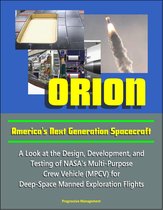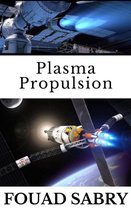Project Orion Nuclear Pulse Rocket, Technical Reports on the Orion Concept, Atomic Bombs Propelling Massive Spaceships to the Planets, External Pulsed Plasma Propulsion Ebook Tooltip Ebooks kunnen worden gelezen op uw computer en op daarvoor geschikte e-readers.
Afbeeldingen
Sla de afbeeldingen overArtikel vergelijken
- Engels
- E-book
- 9781465978578
- 17 augustus 2011
- Epub zonder kopieerbeveiliging (DRM)
Samenvatting
This unique ebook features reproductions of technical reports from NASA and General Atomic on Project Orion, an audacious concept involving the sequential detonation of low-yield atomic bombs to propel large spaceships to the planets. These reports were previously secret and have been declassified. The concept was abandoned by NASA in the mid-1960s, although there was some discussion of the idea in the late 1990s under the term External Pulsed Plasma Propulsion (EPPP).
One of documents excerpted here is from the General Atomic Nuclear Pulse Space Vehicle Study, with spaceship concepts and planetary flight plans, and concepts for launching the bomb-powered craft atop Saturn V and Nexus rocket designs. Technical studies were initiated by General Atomic in 1957 with early Government support awarded in 1958, with the research lead by Ted Taylor and Freeman Dyson. The summary report contents include: Propulsion-system background, Mission Requirements, Lunar-mission Velocities, Exploration-mission Payloads, Vehicle Designs, Propulsion-module Characteristics, Exploration vehicles, Lunar vehicles, Saturn V system compatibility, Performance and Operating Costs, Parametric Study Indications, Exploration Missions, Advanced-vehicle Potential, Operational Considerations, Pulse-created Nuclear Environment, Internal Noise, Ground Facilities and Operations, Ground-Hazards Assessment, Flight-Hazards analysis, Maintenance and repair concepts, Fissionable-material availability, Development Planning, Comparisons with Other Systems.
The introduction states: "The propulsion system operates as follows: low-yield nuclear pulse units are detonated consecutively external to and behind the vehicle. A substantial fraction of the mass of each pulse unit, the propellant, is directed toward the base of the vehicle as a high-velocity, high-density plasma which is intercepted by a large circular metallic plate, the pusher. The momentum of the propellant is transferred to the pusher and the resulting high accelerations are smoothed out by shock-absorbing devices to levels of a few g's in the upper vehicle, well within human tolerances. The propulsion-system performance is characterized by both high thrust-to-weight ratios and large specific impulses... earlier design studies concentrated on vehicles of large sizes (4,000 ton gross weight and some 100 feet in diameter) and quite high specific impulse (4,000 seconds and over). Such vehicles were intended primarily for nuclear-pulse operation starting just above the atmosphere and with initial thrust to weight ratios of about 1.25. At the conclusion of the parametric phase of the NASA study, it became apparent that very significant mission performance, under the less demanding NASA mission constraints, at least, became available using much smaller and lower specific impulse vehicles if operated at lower initial thrust to weight ratios... this study was performed to explore the mission potential of the nuclear-pulse space vehicle concept in the accomplishment of missions meeting the requirements for lunar transportation, lunar logistic, and exploration or logistic missions to the planets, including Mars, Venus, and Jupiter." The study concluded: "A major result was the very significant mission potential of the 10 meter Saturn V compatible nuclear pulse vehicles, particularly when operated in the orbital start up mode... two potential hazards require further consideration, that of boosting aloft large quantities of high explosive packaged with plutonium (in nuclear pulse units) and the potential (though small) contamination of the earth's atmosphere."
Productspecificaties
Inhoud
- Taal
- en
- Bindwijze
- E-book
- Oorspronkelijke releasedatum
- 17 augustus 2011
- Ebook Formaat
- Epub zonder kopieerbeveiliging (DRM)
Betrokkenen
- Hoofdauteur
- Progressive Management
- Hoofduitgeverij
- Smashwords Edition
Lees mogelijkheden
- Lees dit ebook op
- Android (smartphone en tablet) | Kobo e-reader | Desktop (Mac en Windows) | iOS (smartphone en tablet) | Windows (smartphone en tablet)
Overige kenmerken
- Studieboek
- Nee
EAN
- EAN
- 9781465978578
Je vindt dit artikel in
- Categorieën
- Taal
- Engels
- Boek, ebook of luisterboek?
- Ebook
- Beschikbaar in Kobo Plus
- Beschikbaar in Kobo Plus
- Beschikbaarheid
- Leverbaar
Kies gewenste uitvoering
Prijsinformatie en bestellen
De prijs van dit product is 9 euro en 62 cent.- E-book is direct beschikbaar na aankoop
- E-books lezen is voordelig
- Dag en nacht klantenservice
- Veilig betalen
Rapporteer dit artikel
Je wilt melding doen van illegale inhoud over dit artikel:
- Ik wil melding doen als klant
- Ik wil melding doen als autoriteit of trusted flagger
- Ik wil melding doen als partner
- Ik wil melding doen als merkhouder
Geen klant, autoriteit, trusted flagger, merkhouder of partner? Gebruik dan onderstaande link om melding te doen.








